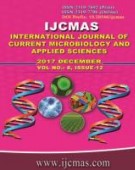


 National Academy of Agricultural Sciences (NAAS)
National Academy of Agricultural Sciences (NAAS)

|
PRINT ISSN : 2319-7692
Online ISSN : 2319-7706 Issues : 12 per year Publisher : Excellent Publishers Email : editorijcmas@gmail.com / submit@ijcmas.com Editor-in-chief: Dr.M.Prakash Index Copernicus ICV 2018: 95.39 NAAS RATING 2020: 5.38 |
Nanotechnology is considered as one of the fastest emerging research fields. It is recognized as the study of particle with a minimum of one dimension in nanometers. Synthesis of nanoparticles can be done through three methods like physical, chemical and biological synthesis methods. Biological synthesis of metal nanoparticles is a new approach for environmentally benign protocol in context to green nanotechnology. Biological synthesis can be done using microorganisms, enzymes or plant extracts. These methods overcome the harmful effects caused by chemical synthesis on environment. Zinc nanoparticles are the mostly synthesized nanoparticles because of their diverse fields of applications. Zinc nanoparticles are highly instable and various chemicals such as poly vinyl pyrrolidone (PVP) are used as coating agents for attaining the stability. Microbial synthesized nanoparticles are bestowed with the mother protein which coats the nanoparticles attaining stability. An attempt is being made in the present work to synthesize zinc nanoparticles from the microorganism isolated from the rhizosphere soil and various parameters to be correlated for the microorganism’s potency to nanoparticle synthesis.
 |
 |
 |
 |
 |